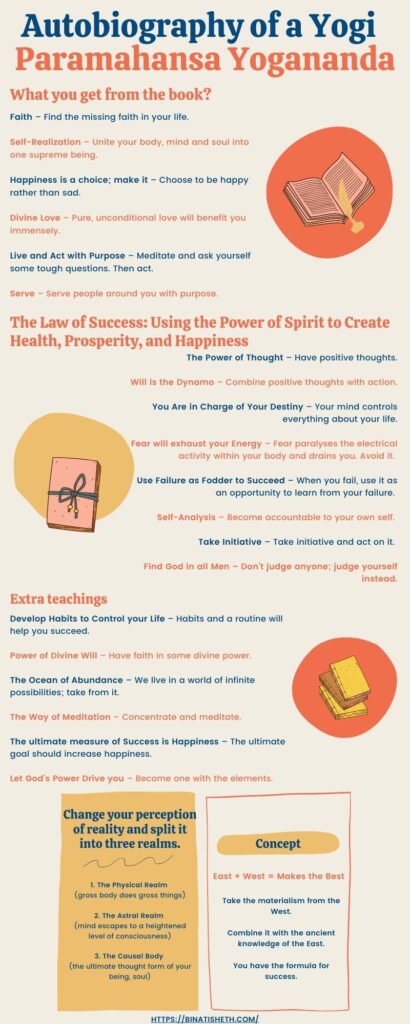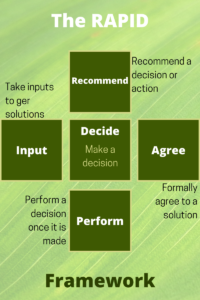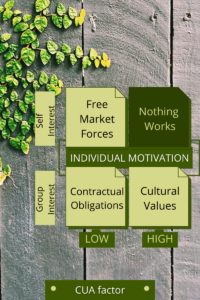
I am not going to summarise this book verbatim because I want you to read and experience this book in its entirety. Trust me (and the many uber successful people) who recommend this book wholeheartedly, okay? That said, this blog is a book summary of sorts.
If you are someone who doesn’t want to read the blog (or the book), you can check this recorded (live) summary.
Whose autobiography is it?
Autobiography of a Yogi by Paramahansa Yogananda is the autobiography of the writer who is a yogi in the truest sense of the word. His spiritual arrival was prophesied by many saints and sages before his birth. He was born in India as Mukunda Lal Ghosh to a wealthy, spiritual Bengali (Hindu) family which couldn’t keep up with their energetic child’s inquisitive, spiritual mind. He was such a curious action taker, even before he became an adult, he found many spiritual gurus, often by running away from home. Gurus all around him were awestruck by this child’s aura.
As Mukunda grew up, he made Lahiri Mahasaya’s (Paramguru of Yogananda/ Yogiraj/ Kashibaba prophecy come true by becoming a Paramhansa, the supreme swan i.e. the enlightened one. He lived with his family, found a guru (Swami Sri Yukteswar), became an ascetic, became a teacher and popularised the Kriya Yoga meditation around the world. Like a fragrant flower that is beautiful, smells divine and brightens our day, his teachings spread far and wide, and left a pleasant aroma behind.
Why should you read this autobiography?
I get it. Why bother with reading about some monk who teaches you yoga, something you can learn from celebrities or influencers online in a visual format?
To that, I say, he doesn’t teach yoga in this book. He teaches us how to be a yogi, an enlightened being. This book questions our perception of reality and shatters it in many places by showing us how reality works (in the karmic way). By showing us his enlightenment process, his spiritual journey, this Indian storyteller shows you the brilliance of ancient wisdom in its simplistic complexity.
He combines the materialism of the West with the ancient wisdom of the East to create a tutorial of sorts to achieve God-tier realisation. He truly shreds the reader’s beliefs of reality in the best way possible.
This book is what you get when someone takes ancient knowledge, removes the distractions and just writes a simple book. You get family, society and the self – what’s not to like about that?
Additionally, he highlights the importance of a holistic education system, something he launched back in the 1940s, something that is required in the present. He talks about amalgamating contemporary education practices (your syllabus, competitive exams and what not) with spiritual practices and yoga. It’s an older yet refreshing take on an education.
The Summary
This man who brought yoga to the West tells us his story, his teachings and his experiences with this book.
He lived with a large family with a heartful mother and a disciplinarian father alongside eight siblings. The family were ardent followers of Lahiri Mahasaya. As he searched for heartfelt spirituality (and failed), something happened – his mother passed away. Before she did though, she communicated with him via the astral plain telling him about her incoming death. Even his own mother got a gift from the divine, a silver (astrophysical) amulet for her beloved Mukunda.
His belief strengthens and he begins the process of escaping to the Himalayas. In doing so, he met many sages who left an impression on him. Then he got caught and was forcefully taken home. There’s a hilarious cat and mouse sequence with his brother Ananta and him which continues again and again.
Then at age seventeen, Mukunda finds his guru, the revered Swami Sri Yukteswar Giri at the Benares market. Unlike the general loving tone of most gurus, Swami Yukteshwar was often cold to Mukunda. However, as their true relationship began lifetimes ago, Mukunda learned from the firm yet loving teaching style of his guruji. It was Sri Yukteshwar who forced Mukunda to go to college (Serampore College) in spite of the complaints of the young sage. His training to become the yogic teacher to the West began.
Under Swami Sri Yukteswar Giri tutelage, Mukunda gets initiated into Kriya Yoga. He finishes his education and departs for the West (specifically the United States), where he stays for most of his life. Over the course of many years and insightful lectures, he launches the Self-Realization Fellowship, something that’s active to this day.
Having transcended from being Mukunda to becoming Yogananda, he meets many spiritual, religious, political, social and civil rights leaders around the world. He practiced religious tolerance on account of his enlightened actualisation of spirituality – the existence of three realms.
- The Physical Realm (where our gross body does gross things)
- The Astral Realm (where our mind escapes to when one has a heightened level of consciousness)
- The Causal Body (the ultimate thought form of your being, soul)
He explains many more complex principles which are better read than summarised (because the summaries will sound crazy).
What I took away from the book
I took quite a few things from this book.
Faith
As an atheist, faith was missing from my life (or so I thought). While reading this book, I realised how I do have faith in things – words, intention and the human spirit.
Self-Realization
The body, mind and soul are united in the one supreme being. In the book, the supreme being is God. You don’t have to seek him/her/it/::insert pronoun of choice::. We simply need to enhance our ability to see, to know.
Happiness is a choice – make it
To quote, “You have come to earth to entertain and to be entertained.”
Yogananda, . Autobiography of a Yogi. Los Angeles, Calif: Self-Realization Fellowship, 2006.
The world and the people in it are beautiful. Stop focusing on the bad stuff all the time and stop to smell the roses once in a while. Choose to be happy.
If you’re happy, you will make others happy. That’s how it is. If you are in a cesspit of misery, that’s what you will attract and you don’t want that.
Divine Love
Unlike the reel version of love, practice the real, unconditional divine love. Love without conditions. Don’t let change, change your love. Pure love will benefit you immensely.
Live and Act with Purpose
Become perceptive. Become conscious. Feel your body, mind and soul separate via deep meditation. It sounds stupid, I know, but I have personally experienced the positive effects of normal meditation. I am guessing deep meditation definitely wouldn’t hurt so worth a shot, right?
He says, “Since you alone are responsible for your thoughts, only you can change them.”
Yogananda, . Autobiography of a Yogi. Los Angeles, Calif: Self-Realization Fellowship, 2006.
Serve
Serve people around you with purpose. Become a magnet that attracts the best things – unselfishness, putting others first, exist to serve. Serve without the intention of getting anything back.
The Law of Success: Using the Power of Spirit to Create Health, Prosperity, and Happiness
The Power of Thought
Your thoughts will shape you.
To quote, “The body is literally manufactured and sustained by mind.”
Yogananda, . Autobiography of a Yogi. Los Angeles, Calif: Self-Realization Fellowship, 2006.
Maintain a positive mind to succeed. Make peace with a negative mind to dwell in mediocrity. Even if you are plagued with a negative mindset, explore it. In the recesses of your darkness, you will see the light via the power of will.
Will is the Dynamo
Just thoughts won’t do anything. You need action as well. Combine positive thoughts with action and your dynamo will power through any kind of darkness and despair.
You Are in Charge of Your Destiny
In My Sassy Girl, a movie, there’s a lovely quote, “Destiny is the bridge you build to the one you love.”
My Sassy Girl. Dir. Yann Samuell. Vertigo Entertainment,2008.
Your mind is in your control. Everything good, bad and neutral happens when you control your mind to a certain path. If you create this path and guide your mind towards the good, the healthy, the successful, the loving, you have achieved your destiny.
Use your will to guide you here. A strong, unbreakable will which won’t bend to any external stimuli will help you shape your destiny.
Fear will exhaust your Energy
Fear paralyses the electrical activity within your body. It will literally drain you. You will be weakened. Your body will be put on alert. That results in unnecessary energy wasted which impacts your internal organs.
Fear is one thing you have to give up on to succeed because it inhibits you in every way possible.
Use Failure as Fodder to Succeed
When you fail, and you will, use it as an opportunity to learn. Learn from your failure.
What did you do well?
What can you improve?
What was a crock of shit and should be dumped forever?
Learn, unlearn, move on.
Self-Analysis
You need to be accountable to your own self. Introspect in front of your soul mirror. Analyse your mind. Diagnose your spirit and will. Ask yourself some important questions.
Who am I?
Who do I want to become?
What is stopping me?
Analyse yourself.
Take Initiative
When you say, “I will do this for you,” you are taking initiative. Your inner creative is reaching out and asking you to create. Act on this. It will let you learn new things every single day. It will attract amazing opportunities over and over again.
Find God in all Men
Don’t be an asshole. Be nice to people. Don’t judge anyone. Be sceptical but not cynical. Self-examine over overtly judgemental.
Develop Habits to Control your Life
Habits help a lot. Having a daily routine will help you hasten your success. A habit will save you mental energy. Energy you waste making choices can now be used to think creatively. Have holistic habits.
Power of Divine Will
Divine will, luck, whatever you want to call it, this doesn’t have any boundaries. This is the realm of possibilities, miracles and discoveries. This is the power that runs the world. Have faith.
The Ocean of Abundance
The world is an ocean of infinite possibilities. It is abundant. To receive from this abundance, we have to learn to ask, to become confident. Cast the scarcity and the limitation mindset aside. Have confidence in your abilities and the Divine – you will succeed.
Practice meditation to see and seek from the ocean of abundance.
The Way of Meditation
Concentrate.
Meditate.
Two words are all you need to truly succeed. Meditation and concentration have become the buzzwords of the coaching/mentoring industry for a reason. They really work.
Concentrate on self. Then meditate.
Concentrate on your craft. Meditate in the form of deep work.
Concentrate on your relationships. Meditate in the state of true happiness.
We are solution oriented. That’s what separates mankind from animal-kind. Go into the recesses of your mind via concentrated meditation and figure it out.
The ultimate measure of Success is Happiness
To quote, “The power of unfulfilled desires is the root of all man’s slavery”
Yogananda, . Autobiography of a Yogi. Los Angeles, Calif: Self-Realization Fellowship, 2006.
Just ask yourself what success is. Ultimately, it comes to being happy.
Let God’s Power Drive you
Unleash the power within you. God (or whatever you prefer) will provide more. Personally, I prefer nature. Nature keeps giving us things even if we take and take from it. God/Nature, they are the power you possess. Release this power and more will come.
Become one with the elements or whatever you prefer. The solutions to all your problems lie right there in front of you, all around you. Just look.
To conclude,
I recommend you read the book at least once. Ideally, you want to read this book over and over again. It is complex. It is simple. It has certain issues like putting too much trust in the divine, a possible risk of paedophilia exposure, and religious indoctrination. I am going to trust you to be an adult here and think critically and learn from the best this book has to offer.
If you liked this book summary, you might like other. Find them here.
Also, let me know how you liked the book once you read it.
If you have already read it, tell me (in the comment section), how did you like the book?
Thank you so much for reading and sharing your thoughts. If you’d like to read more, feel free to browse through the blogs and the essays. If you want some amazing verbal goodies delivered to your inbox monthly, fill in your fabulous details down under.





